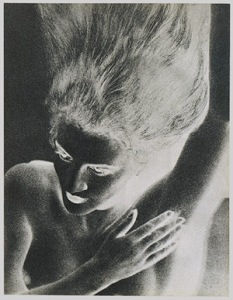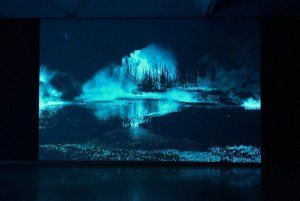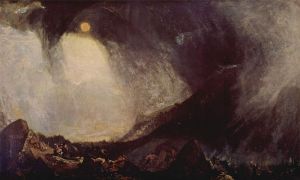Between 1907 and 1914 Pablo Picasso and Georges Braque collaborated to create Cubism. The work of Paul Cézanne and tribal art are considered the major influences of the movement.
Cubism rejected traditional modes of representation, these included emulating nature, creating a three dimensional picture plane using perspective and foreshortening and other inherited modelling techniques. The Cubist’s in fact wanted to accentuate the two-dimensionality of the canvas. (1)
The Cubist’s reduced and fractured objects into geometric forms, they used multiple and contrasting viewpoints to capture the essence of an object or scene and they realigned these components within a shallow and relief-like space upon the canvas. (2)
Both artist’s greatly admired the work of Cézanne and in 1908 Braque imitated Cézanne’s landscapes of L’Estaque in Southern France. Cézanne painted the town often and Braque was immensely influenced by his work when he saw it in a memorial exhibition in Paris in 1907. (3)
Paul Cézanne, The Riaux Valley near L’Estaque, 1883.
Georges Braque, Road near L’Estaque, 1908.
The impact of Picasso’s avant-garde painting Les Demoiselles d’Avignon, 1907 was immense. Picasso’s stylized and distorted forms were drawn from Iberian sculpture and African masks. Picasso first saw African art earlier that year in Paris at the Ethnographic Museum in the Palais du Trocadero.
Pablo Picasso, Les Demoiselles d’Avignon, 1907.
Picasso in his studio with his collection of African art, 1908.
In 1982, an exhibition called “Cubism and American Photography, 1910-30” opened at the International Museum of Photography at George Eastman House in Rochester. The curators asserted that Cubism in painting promoted the formation of a truly modern photographic style. (4)
The curators, John Pultz and Catherine B. Scallen, suggested that the Armory Show of 1913, which brought modern French painting and sculpture, including Cubist works to the United States significantly influenced Paul Strand. Alfred Stieglitz considered Strand’s work avant-garde. Strand’s “close up photographs were crispy lit, dynamically composed and superficially abstract.” (5)
Paul Strand, Abstraction, Porch Shadows, Connecticut, 1916.
Stieglitz renounced Pictorialism’s painterly aesthetic and photographer’s began engaging with the medium’s “unique properties and capabilities.” (6)
In Grundberg’s article about the 1982 exhibition, he claims that the curators have failed to recognize the impact of other art movements such as Suprematism, Constructivism and Surrealism upon photography. Figures such as Aleksandr Rodchenko and Laszlo Moholy-Nagy also contributed to the new style that was appearing in photography. “Straight photography” was sharply focused, unmanipulated and unsentimental. (7)
Aleksandr Rodchenko, Composition, 1918.
Laszlo Moholy-Nagy, Untitled, 1923.
More recently, in terms of Cubism and photography, David Hockney’s experiments are of interest. Hockney created a new way of making photographs more akin to that of a painting or drawing in terms of time. He writes, “A photograph is… a fraction of a second, frozen. So, the moment you’ve looked at it for even four seconds, you’re looking at it far more than the camera did. It dawned on me this was visible, actually, it is visible, and the more you become aware of it, the more this is a terrible weakness; drawings and paintings do not have this.” (8) Hockney stands in place and photographs a scene as it unfolds before him. He then joins the photographs together to create one picture.
David Hockney, “Joiner” Self Portrait.
David Hockney, “Joiner” Gregory and David.
In 1983, Melvyn Bragg’s art series, The South Bank Show, visited Hockney at his home in LA. Hockney was filmed as he created a “Joiner” portrait especially for the documentary of two women drinking tea. (9)
Watch on Youtube David Hockney “Joiners”
References
1. http://www.metmuseum.org/toah/hd/cube/hd_cube.htm
2. http://www.metmuseum.org/toah/hd/cube/hd_cube.htm
3. http://www.moma.org/collection/object.php?object_id=78787
4. http://www.nytimes.com/1981/12/13/arts/photography-view-what-was-cubism-s-impact.html?pagewanted=2
5. http://www.nytimes.com/1981/12/13/arts/photography-view-what-was-cubism-s-impact.html?pagewanted=2
6. http://www.nytimes.com/1981/12/13/arts/photography-view-what-was-cubism-s-impact.html?pagewanted=2
7. http://www.nytimes.com/1981/12/13/arts/photography-view-what-was-cubism-s-impact.html?pagewanted=2
8. http://dangerousminds.net/comments/david_hockneys_cubist_photography
9. http://dangerousminds.net/comments/david_hockneys_cubist_photography
Images
Paul Cézanne, The Riaux Valley near L’Estaque, 1883. http://commons.wikimedia.org/wiki/File:Paul_C%C3%A9zanne_-_Houses_in_Provence-_The_Riaux_Valley_near_L’Estaque_-_Google_Art_Project.jpg
Georges Braque, Road near L’Estaque, 1908. http://www.moma.org/collection/object.php?object_id=78787
Pablo Picasso, Les Demoiselles d’Avignon, 1907. http://www.moma.org/collection/object.php?object_id=79766
Picasso in his studio at the Bateau-Lavoir, Paris, 1908, Musée Picasso, Paris. Photo Credit: Réunion des Musées Nationaux. https://uncrated.wordpress.com/2012/06/12/picasso-and-african-art/
Paul Strand, Abstraction, Porch Shadows, Connecticut, 1916. http://www.moma.org/collection//browse_results.php?criteria=O%3AAD%3AE%3A5685&page_number=12&template_id=1&sort_order=1
Aleksandr Rodchenko, Composition, 1918. http://www.moma.org/collection/browse_results.php?criteria=O%3AAD%3AE%3A4975&page_number=2&template_id=1&sort_order=1
Laszlo Moholy-Nagy, Untitled, 1923. http://www.moma.org/collection/browse_results.php?criteria=O%3AAD%3AE%3A4048&page_number=1&template_id=1&sort_order=1
David Hockney, “Joiner” Self Portrait. http://dangerousminds.net/comments/david_hockneys_cubist_photography
David Hockney, “Joiner” Gregory and David. http://dangerousminds.net/comments/david_hockneys_cubist_photography
Youtube “David Hockney Joiners.” https://www.youtube.com/watch?v=cGtraVb_0vY#t=265

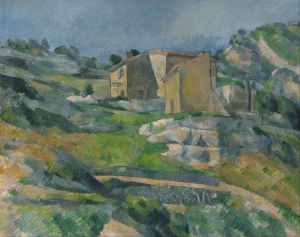

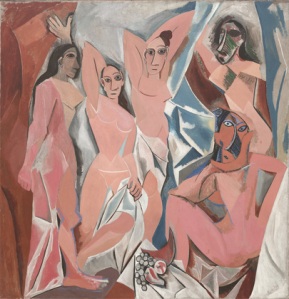


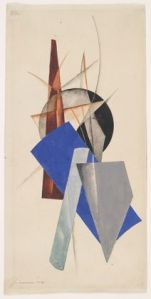



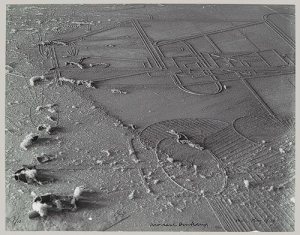
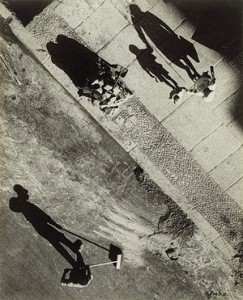 Otto Umbehr, Mystery of the Street, 1928.
Otto Umbehr, Mystery of the Street, 1928.
